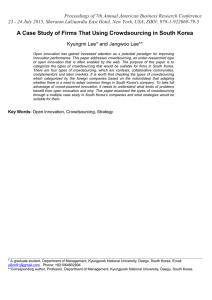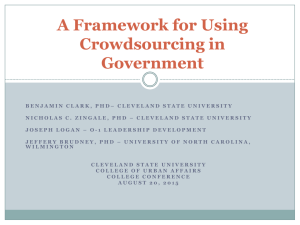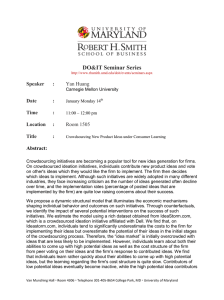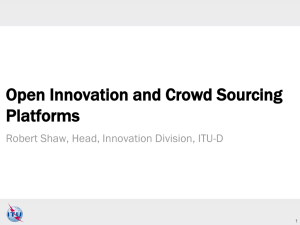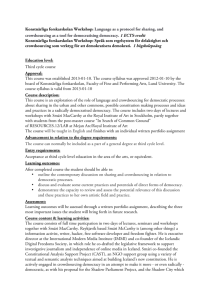Efficient Crowdsourcing With Stochastic Production Ruggiero Cavallo Shaili Jain
advertisement
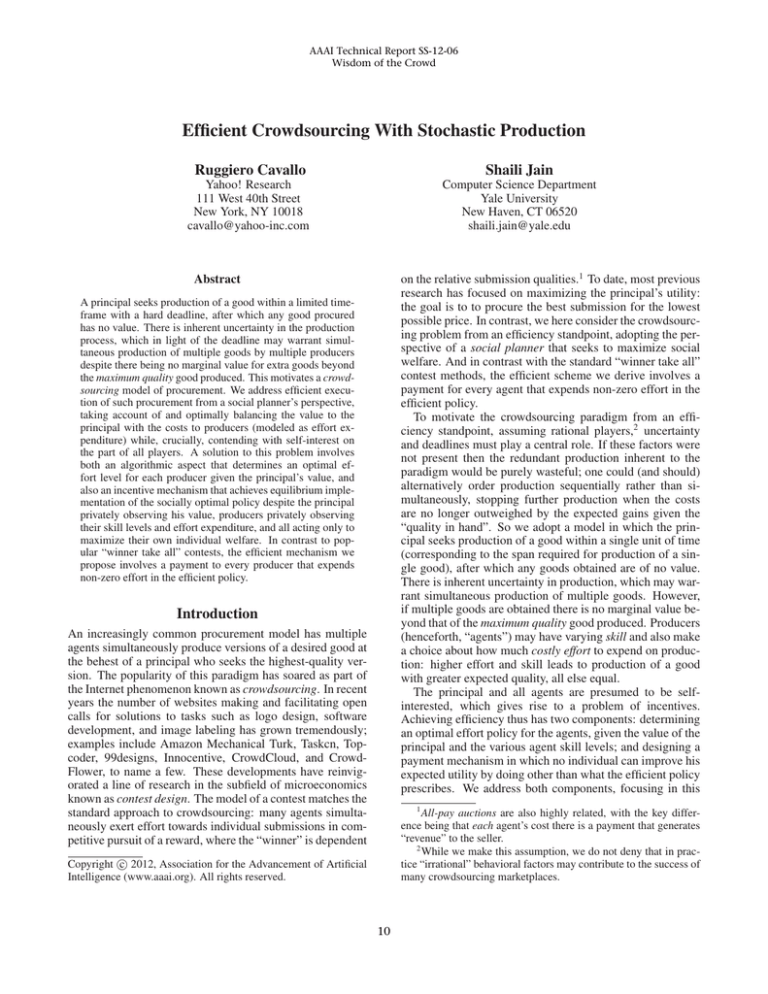
AAAI Technical Report SS-12-06
Wisdom of the Crowd
Efficient Crowdsourcing With Stochastic Production
Ruggiero Cavallo
Shaili Jain
Yahoo! Research
111 West 40th Street
New York, NY 10018
cavallo@yahoo-inc.com
Computer Science Department
Yale University
New Haven, CT 06520
shaili.jain@yale.edu
on the relative submission qualities.1 To date, most previous
research has focused on maximizing the principal’s utility:
the goal is to to procure the best submission for the lowest
possible price. In contrast, we here consider the crowdsourcing problem from an efficiency standpoint, adopting the perspective of a social planner that seeks to maximize social
welfare. And in contrast with the standard “winner take all”
contest methods, the efficient scheme we derive involves a
payment for every agent that expends non-zero effort in the
efficient policy.
To motivate the crowdsourcing paradigm from an efficiency standpoint, assuming rational players,2 uncertainty
and deadlines must play a central role. If these factors were
not present then the redundant production inherent to the
paradigm would be purely wasteful; one could (and should)
alternatively order production sequentially rather than simultaneously, stopping further production when the costs
are no longer outweighed by the expected gains given the
“quality in hand”. So we adopt a model in which the principal seeks production of a good within a single unit of time
(corresponding to the span required for production of a single good), after which any goods obtained are of no value.
There is inherent uncertainty in production, which may warrant simultaneous production of multiple goods. However,
if multiple goods are obtained there is no marginal value beyond that of the maximum quality good produced. Producers
(henceforth, “agents”) may have varying skill and also make
a choice about how much costly effort to expend on production: higher effort and skill leads to production of a good
with greater expected quality, all else equal.
The principal and all agents are presumed to be selfinterested, which gives rise to a problem of incentives.
Achieving efficiency thus has two components: determining
an optimal effort policy for the agents, given the value of the
principal and the various agent skill levels; and designing a
payment mechanism in which no individual can improve his
expected utility by doing other than what the efficient policy
prescribes. We address both components, focusing in this
Abstract
A principal seeks production of a good within a limited timeframe with a hard deadline, after which any good procured
has no value. There is inherent uncertainty in the production
process, which in light of the deadline may warrant simultaneous production of multiple goods by multiple producers
despite there being no marginal value for extra goods beyond
the maximum quality good produced. This motivates a crowdsourcing model of procurement. We address efficient execution of such procurement from a social planner’s perspective,
taking account of and optimally balancing the value to the
principal with the costs to producers (modeled as effort expenditure) while, crucially, contending with self-interest on
the part of all players. A solution to this problem involves
both an algorithmic aspect that determines an optimal effort level for each producer given the principal’s value, and
also an incentive mechanism that achieves equilibrium implementation of the socially optimal policy despite the principal
privately observing his value, producers privately observing
their skill levels and effort expenditure, and all acting only to
maximize their own individual welfare. In contrast to popular “winner take all” contests, the efficient mechanism we
propose involves a payment to every producer that expends
non-zero effort in the efficient policy.
Introduction
An increasingly common procurement model has multiple
agents simultaneously produce versions of a desired good at
the behest of a principal who seeks the highest-quality version. The popularity of this paradigm has soared as part of
the Internet phenomenon known as crowdsourcing. In recent
years the number of websites making and facilitating open
calls for solutions to tasks such as logo design, software
development, and image labeling has grown tremendously;
examples include Amazon Mechanical Turk, Taskcn, Topcoder, 99designs, Innocentive, CrowdCloud, and CrowdFlower, to name a few. These developments have reinvigorated a line of research in the subfield of microeconomics
known as contest design. The model of a contest matches the
standard approach to crowdsourcing: many agents simultaneously exert effort towards individual submissions in competitive pursuit of a reward, where the “winner” is dependent
1
All-pay auctions are also highly related, with the key difference being that each agent’s cost there is a payment that generates
“revenue” to the seller.
2
While we make this assumption, we do not deny that in practice “irrational” behavioral factors may contribute to the success of
many crowdsourcing marketplaces.
c 2012, Association for the Advancement of Artificial
Copyright Intelligence (www.aaai.org). All rights reserved.
10
short version of the paper on the case where skill is constant
across agents, for which we derive an efficient, individually
rational, and budget-balanced solution.
Finally, this work overlaps with the broader agenda of
incentives in peer production systems, where there has
been work addressing incentives in question and answer
forums, human computation, etc. [Jain and Parkes, 2008;
Jain, Chen, and Parkes, 2009; Jain and Parkes, 2009;
Ghosh and McAfee, 2011; Ghosh and Hummel, 2011].
Related Work
There has recently been work explicitly addressing the theory of crowdsourcing, in a model where agents have private information about a skill parameter and choose an effort level. DiPalantino and Vojnovic [2009] make the connection to all-pay auctions and model a market with multiple
contests, considering the principal’s optimization problem in
the limit-case as the number of agents and contests goes to
infinity. Archak and Sundararajan [2009] and Chawla, Hartline, and Sivan [2011] focus on the design of a single contest; the problem consists of determining how many prizes
should be awarded, and of what value. Chawla et al. make
the connection between crowdsourcing contests and optimal
auction design, finding that the optimal crowdsourcing contest is a virtual valuation maximizer.
However, these papers consider a deterministic model of
quality as a function of effort and skill, under which, if the
principal’s value equals the maximum value over the produced goods, the crowdsourcing paradigm itself is not wellmotivated from an efficiency standpoint. While in this paper we are concerned with social welfare, this prior work
is geared towards maximizing utility of the principal alone
and is unconcerned with the cost to the agents. This focus
is characteristic of the broader literature: in both computer
science and economics prior work has, for the most part,
focused on maximizing submission quality, whether it be
the total sum of submission qualities [Moldovanu and Sela,
2001; 2006; Minor, 2011], the top k submissions less the
monetary reward [Archak and Sundararajan, 2009], or only
the highest quality submission [Moldovanu and Sela, 2006;
Chawla, Hartline, and Sivan, 2011].
This ties in with the extensive literature in economics devoted to the design of optimal contests. Many of these works
consider a contest model where the prize value is known to
all players [Tullock, 1980; Moulin, 1986; Baye, Kovenock,
and de Vries, 1996], while others adopt a model of incomplete information with respect to the prize [Weber, 1985;
Hilman and Riley, 1989; Krishna and Morgan, 1997]. There
has also been work on research tournaments that award a
single prize. For instance in [Fullerton and McAfee, 1999],
agents have a cost of production—drawn from a known
distribution—that becomes common knowledge after a first
round in which agents simultaneously decide whether to participate; then in a second round agents decide how much
effort to exert given the common-knowledge costs. The authors find that the optimal contest should include only the
two most skilled agents and propose using an all-pay auction
to “select” these two contestants before the actual contest.
A related line of work uses contests to extract effort under
a hidden action [Lazear and Rosen, 1981; Green and Stokey,
1983; Nalebuff and Stiglitz, 1983]. Similar to our work, the
output is a stochastic function of the unobservable effort,
but the setting is different in that the principal obtains value
from the cumulative effort of the agents, rather than just the
maximum result.
Preliminaries
In the crowdsourcing paradigm multiple units of a good
are produced and submitted simultaneously to a principal.
There is a set of agents I = {1, . . . , n} capable of producing
goods, where each i ∈ I has private skill level si ∈ [0, 1].
Agents can expend variable effort on production of the good.
If an agent attempts production, a good is produced with
quality that is a priori uncertain but is a function of the
agent’s skill and effort expended.
Quality is identified with value to the principal in dollarterms. The probability distribution over relative quality,
given any skill and effort levels, is publicly known, but the
absolute quality in terms of value to the principal is not. The
principal has private type v ∈ <+ , a scale factor corresponding to his value for the maximum quality good that could
possibly be produced, and this, given the known distribution
over relative qualities, defines the distribution over absolute
quality (henceforth just “quality”) corresponding to the principal’s value.3 An effort level δi is identified with the dollar
value in costs ascribed to it by agent i. For simplicity we
assume that δi ∈ [0, 1], ∀i ∈ I.4 Then, given a v ∈ <+ , skill
level si , and effort level δi ∈ [0, 1], we denote the p.d.f. and
c.d.f. over resulting quality as fsvi ,δi and Fsvi ,δi , respectively.
We assume symmetry across bidders in the sense that skill
is the only differentiating factor; i.e., for two agents with
the same skill level applying the same effort, the distribution over quality is the same (though there is no presumed
correlation so the resulting quality may differ).
We will make the natural assumption that for an agent
with any given skill level, more effort has first-order stochastic dominance over less effort with respect to quality, i.e.:
∀si , ∀0 ≤ δi < δi0 ≤ 1, ∀x ∈ [0, v], Fsvi ,δi (x) ≥ Fsvi ,δi0 (x),
(1)
and also that, given any effort level, more skill has first-order
stochastic dominance over less skill with respect to quality:
∀δi , ∀0 ≤ si < s0i ≤ 1, ∀x ∈ [0, v], Fsvi ,δi (x) ≥ Fsv0i ,δi (x)
(2)
Because agents are self-interested there is a problem of
incentives: v and si are private information, and expended
effort is privately observed. We adopt a quasilinear utility
model and assume all players are risk-neutral. Given our
identification of the quality of the good with the dollar value
ascribed to it by the principal, and effort level δi with the
dollar value in costs ascribed to it by agent i, quasilinearity implies that the principal’s utility equals the quality of
3
E.g., if quality q ranges in [0, 1], absolute quality equals vq.
The specific range of effort levels is not conceptually important; it is the relationship between the effort levels and v that is
relevant for determining an optimal policy.
4
11
For any constant skill environment (say skill equals ŝ for
each agent) where we can establish that an extreme-effort
policy is optimal, fully determining an efficient policy is
easy. We simply need to compute:
Z v
∗
v
m−1 v
m = arg max m Fŝ,1 (x)
fŝ,1 (x)x dx − m (6)
the good procured minus any payments he must make, and
each agent’s utility equals any payment he receives minus
the effort he expends.
We are concerned with the socially optimal choice of effort level for each agent, where in light of our utility model
the appropriate optimization is the maximum quality level of
the goods produced minus total effort expended; i.e., letting
Qi (v, si , δi ) be the random variable representing the quality
level produced by i ∈ I who has skill level si and expends
effort δi (with v the principal’s value), we seek to maximize:
X
E[max Qi (v, si , δi )] −
δi
(3)
i∈I
m∈{0,...,n}
0
∗
m agents will participate with full-effort and the other n −
m∗ will not participate (i.e., will apply 0 effort).
When skill is not constant, by Eq. (2) having an agent participate who has less skill than one who does not participate
could never be optimal. So more generally, for any setting
where extreme-effort has been established as efficient we
can determine a precise optimal policy by iteratively considering each agent in decreasing order of skill, accepting
agents for (full-effort) participation until stopping and accepting no more in the ordered list.
i∈I
An effort policy is a function of the principal’s value and
the agents’ skill levels. We let δ ∗ (v, s) denote an efficient
policy, i.e., a vector of effort levels that maximizes Eq. (3)
given values of v and s = (s1 , . . . , sn ); when context is
clear we write δi∗ as shorthand for δi∗ (v, s). Given our quasilinear utility model, a policy δ ∗ that maximizes Eq. (3) maximizes the expected sum of utilities and is Pareto efficient.
At various points we will consider a restricted setting
where skill is constant (and publicly known) throughout the
population of agents; we call this the constant skill case.
Uniformly distributed quality
We now look at specific distributional settings, starting with
one in which quality is uniformly distributed between 0 and
the product of the principal’s value and the agent’s skill and
effort. That is, we take Fsvi ,δi for each i ∈ I to be the uniform distribution over quality levels between 0 and δi si v,
i.e.,
(
1
if x ∈ [0, δi si v]
v
δi si v
fsi ,δi (x) =
(7)
0
otherwise
Efficient effort policies
In this section we address the problem of computing an efficient policy given full knowledge of the principal’s value
v and agent skill levels s, and given that agents will execute the effort policy that is prescribed. Then in the next
section we address the question of how to implement such a
policy in the context of a principal and agents that are selfinterested and strategic. We will make use of the following lemma, which demonstrates sufficient conditions under
which extreme-effort policies are optimal.5
Lemma 1. For arbitrary i ∈ I with arbitrary skill si , for
arbitrary skill levels of the other agents and value v for the
principal, fix an arbitrary effort policy for agents other than
i. Amongst effort levels for i in arbitrary interval [a, b] ⊆
[0, 1] it is either optimal for i to expend effort δi = a or
optimal for i to expend effort δi = b if the following holds:
∀β ∈ [0, v], ∀ ∈ [a, b),
Z
∂ v v
−
Fsi ,δi (x) dx ≥1
(4)
∂δi β
δi =
Z
∂ v v
⇒ −
Fsi ,δi (x) dx ≥ 1, ∀k ∈ [, b] (5)
∂δi β
δi =k
We call this the uniformly distributed quality case. The
range of possible qualities (and expected quality) increases
linearly with skill and effort (see Figure 1). We can use
Lemma 1 to show that an extreme-effort policy is optimal
here.
uniformly distributed quality
= 0.25
= 0.5
=1
probability density
4/v
2/v
1/v
0
v/4
Corollary 1. For environments where the quality distribution functions satisfy the relationship of Eqs. (4) and (5) in
Lemma 1 over the full range of effort levels [0, 1], an efficient
effort policy consists of full-effort participation by a subset
of the agents and non-participation by the others.
Note that the lemma holding for the interval [0, 1] is sufficient but not necessary for the optimal policy to involve only
extreme-effort (i.e., effort 0 or 1 by all agents).
v/2
quality
v
Figure 1: Probability density over quality levels for varying degrees of effort, for an agent with skill level 1 in the
uniformly distributed quality case.
Lemma 2. For the uniformly distributed quality case, for
arbitrary skill levels, there is an efficient policy in which
each agent i ∈ I exerts either no effort δi = 0 or full effort δi = 1.
5
All proofs are omitted due to space; we refer the interested
reader to the full version of the paper.
12
Thus computing an efficient policy can be reduced to
choosing the optimal set of agents to participate, who will
participate with maximum effort. In the constant skill case
where all agents have the same skill level (normalized to
1, below) this reduces to choosing the optimal number of
agents to participate.
Theorem 1. For the constant skill, uniformly distributed
quality case, a mechanism that elicits maximum-effort participation by m∗ arbitrary agents (and 0-effort participation
by others) is efficient, where:
( √
b vc − 1
m =
√
b vc
∗
√
√
if b vc2 + b vc > v
otherwise
very low threshold (2.8), when skill equals 1 there is no possibility that anything other than extreme-effort could be optimal. Checking for lower skill levels, we notice that the small
range of values for which extreme-effort is not demonstrably
optimal shrinks further.
We emphasize that we are only checking certain sufficient
conditions: extreme-effort may well be optimal even when
the conditions fail. Then, given that an extreme-effort policy is efficient we can easily compute the optimal number
m∗ of full-effort participants according to Eq. (6). Figure
3 depicts efficiency as a function of number of participants,
for various v.
(8)
optimal number of participants
45
40
expected social welfare
Figure 2 depicts how the optimal number of participating
agents relates to the principal’s value.
optimal number of full-effort participants
m* as a function of v
9
8
7
6
35
v=3
v=20
v=50
30
25
20
15
10
5
5
0
4
-5
0
3
1
2
3
4
5
number of (full-effort) participants
6
7
3.1in
2
Figure 3: Expected social welfare as a function of the number of agents participating with full-effort (where others exert no effort), for various instantiations of the principal’s
value v in the normally distributed quality case. As v rises
the marginal value of extra quality increases, and accordingly the efficient level of participation rises.
1
0
0
10
20
30
40
50
v
60
70
80
90
100
Figure 2: Optimal number of agents that should produce a
good (with full effort) in the uniform quality case, as a function of the principal’s value v.
Incentives
Normally distributed quality
We now consider the problem of implementing an efficient
policy in a context of selfish players. Since utility in our
setting is quasilinear and thus transferable, we can use monetary payments as a tool: our goal will be to realign every
player’s incentives with the maximization of social welfare,
so that each player maximizes his own utility exactly when
the sum of all players’ utilities is maximized. We seek an
equilibrium solution where no agent can gain by doing anything other than what the mechanism asks, as follows:
While for more complex distributions beyond the uniform
case we would have difficulty demonstrating similar results
analytically, we can query whether Lemma 1 holds experimentally. We now consider quality that is normally distributed, over a bounded interval, with mean increasing proportional to effort and skill. Specifically, consider the truncated normal distribution over the interval [0, v], with location parameter µ = δi si and scale parameter σ = v/8.
For Rarbitrary v, β, and δi we can computationally approxv
imate β Fsvi ,δi (x) dx and accordingly evaluate whether the
conditions of Lemma 1 are satisfied. But a more direct approach is equally tractable here: we can simply compute the
expected marginal value, given any β, of effort for arbitrarily fine discretizations of the effort space δi ∈ [0, 1]. Then,
we check whether extreme-effort is optimal for all β in the
range [0, v], as this would imply that regardless of the quality
obtained by agents other than arbitrary i ∈ I, for i extreme
effort (0 or 1) is optimal. We checked this by again discretizing the search space; this time the space in question is that
of possible (v, β) pairs where β is constrained to fall within
[0, v]. The results indicate that for all values of v above a
Definition 1 (incentive compatibility). A mechanism is incentive compatible if for each player i, given that all other
players abide by the mechanism’s prescriptions, i’s expected
utility can never be improved by doing other than what the
mechanism prescribes.
This definition is a generalization of the standard “truthful reporting” definition that is sufficient for mechanisms
that only involve sharing of private information. In our setting, one player (the principal) must share private information truthfully, while others (the agents) must behave faithfully according to what the mechanism prescribes and will
also have to share private information if skill is variable and
13
private knowledge.6 An incentive compatible mechanism
gives us reason to believe that the outcome the mechanism
prescribes will occur, given rational agents. But for a mechanism that makes payments there are other constraints: the
mechanism should be weakly budget-balanced, in expectation never paying out more than it takes in, since otherwise
an external subsidy would be required for its implementation. The mechanism should also be individually rational,
meaning no agent should expect to be worse off in equilibrium from truthfully participating.
In this short version of the paper for the incentives analysis we present results only for a context of constant skill,
where two agents exerting the same effort produce quality according to the same distribution. In the full paper
we develop a theory of incentives for the general private
skill model. Recall that an efficient effort policy δ ∗ =
(δ1∗ , . . . , δn∗ ) is a function of the principal’s value and the
vector of agents’ skill levels s; so in constant skill settings
the only “variable” relevant to computation of δ ∗ is v, and
we omit s from all notation. The mechanism we propose
is efficient and incentive compatible in such settings, and
also individually rational and budget balanced. It defines
payments that, in some cases, depend on a priori expected
quality for a given effort level.
We use notation Qi (v, δi ) for the random variable representing the quality produced when agent i expends effort
δi , given the principal’s value v, and Qi (v) to denote an actual quality level realized by i (Qi will be 0 by default if
δi = 0). One can either assume the quality of a produced
good given any v is publicly observable or, alternatively, in
settings where this is unrealistic the mechanism proposed
below can be slightly (and harmlessly) modified to have the
principal report the quality level of each produced good.
Q(v) denotes the vector (Q1 (v), . . . , Qn (v)) and Q−i (v)
denotes (Q1 (v), . . . , Qn (v)) with Qi (v) excluded; analogously Q(v, δ) denotes (Q1 (v, δ1 ), . . . , Qn (v, δn )) and
Q−i (v, δ−i ) denotes the same excluding Qi (v, δi ). For any
vector x we let x(k) denote the k th highest element of x.
The principal pays the sum of the prescribed effort levels;
each agent is paid his prescribed effort minus the expected
difference between the highest quality level overall and the
highest quality level achieved by the other agents; each agent
is also paid the difference between the actual highest quality
level produced overall and the highest quality level produced
by the other agents—this value is 0 for all agents except he
who produces the highest quality good, and thus that agent
(h) obtains a “bonus” payment (Qh (v) − Q(2) (v)).
Theorem 2. Mechanism 1 is efficient, incentive compatible, individually rational, and budget balanced in expectation for constant skill settings.
Let us consider an example. Imagine there are three
agents (with constant skill equal to 1), a principal with
value v = 8, and uniformly distributed quality. We
can
1 to determine an optimal policy: since
√ use Theorem
√
b√vc2 + b vc = 6 < v = 8, the optimal policy calls for
b vc = 2 agents—say agents 1 and 2—to expend effort
δ1 = δ2 = 1 and the third to expend effort δ3 = 0. Imagine
that the realized quality levels turn out to be Q1 = 3 and
Q2 = 5. The mechanism requires that the principal pay:
δ1 + δ2 + δ3 = 2. Noting that E[Q(1) (8, (1, 1, 0))] = 16
3 and
(1)
E[Q (8, (1, 0))] = 4, agent 1 is paid:
16
1
1−
−4 =− ,
(12)
3
3
i.e., he is charged 1/3. Agent 2, the maximum qualityproducing agent, is paid:
16
5
1 + (5 − 3) −
−4 =
(13)
3
3
Finally, agent 3 is paid: 0 − (0 − 0) = 0. Each agent’s
utility equals his payment minus effort (−4/3 for agent 1,
2/3 for agent 2, and 0 for agent 3); the principal’s utility
equals 5 − (1 + 1) = 3; and revenue to the mechanism
designer equals 2 + 1/3 − 5/3 = 2/3. No agent could have
gained in expectation from deviating from the mechanism’s
prescriptions, and although agent 1 was worse off for having
participated, in expectation he was not so participation is
rational given risk-neutrality.
Mechanism 1. The principal reports v and then efficient effort levels δ1∗ , . . . , δn∗ are computed. Each
agent i is instructed to expend effort δi∗ on production,
and goods are produced with quality levels Q(v) =
(Q1 (v), . . . , Qn (v)). The principal is charged:
X
δi∗ ,
(9)
One thing about the mechanism that could arguably be
called a flaw is the fact that agents do not have a strict incentive to participate: their expected utility from doing so is 0.
First of all we note that the effort cost δi for an agent can be
understood to incorporate opportunity costs, and can thus be
construed as the difference in cost between the given effort
level and the value of the agent’s “outside option” (which
will equal 0 if the agent has no other options).
But in some cases we can go further. Note that the principal does obtain positive surplus from the mechanism; in fact
he is the only player (including the mechanism designer) that
does so in expectation. We can seek to distribute this more
broadly. If the mechanism designer knows—independent of
his announcement—that the principal’s value is greater than
or equal to some value v, then let:
X
G = E[Q(1) (v, δ ∗ (v))] −
δi∗ (v)
(14)
i∈I
agent h = arg maxi∈I Qi (v) is paid:
(1)
∗
δh∗ + Qh (v) − Q(2) (v) − E[Q(1) (v, δ ∗ ) − Q−h (v, δ−h
)],
(10)
and each other agent i ∈ I \ {h} is paid:
(1)
∗
δi∗ − E[Q(1) (v, δ ∗ ) − Q−i (v, δ−i
)]
(11)
6
This dual-nature incentive situation appears in many other scenarios; see [Shneidman and Parkes, 2004] and [Cavallo and Parkes,
2008] for precedents in the literature.
i∈I
14
We can amend Mechanism 1 by charging the principal G
and paying each agent G/n. Since G is completely independent of the principal’s report, charging him thus will not
change his incentives. Because quality is monotonically increasing in the principal’s value, G constitutes a lower bound
(guarantee) on the expected surplus the principal obtains in
equilibrium under Mechanism 1, and so individual rationality will still hold in the amended mechanism. ∀v in the space
of possible values, the principal’s expected utility will equal:
X
E[Q(1) (v, δ ∗ (v))] −
δi∗ (v) − G
(15)
Cavallo, R., and Parkes, D. C. 2008. Efficient metadeliberation
auctions. In Proceedings of the 26th Annual Conference on Artificial Intelligence (AAAI-08), 50–56.
Cavallo, R. 2006. Optimal decision-making with minimal waste:
Strategyproof redistribution of VCG payments. In Proceedings of
the 5th International Conference on Autonomous Agents and MultiAgent Systems (AAMAS-06), 882–889.
Chawla, S.; Hartline, J.; and Sivan, B. 2011. Optimal crowdsourcing contests. In Proceedings of the 23rd ACM-SIAM Symposium
on Discrete Algorithms (SODA-12), 856–868.
DiPalantino, D., and Vojnovic, M. 2009. Crowdsourcing and allpay auctions. In Proceedings of the 10th ACM Conference on Electronic Commerce (EC-09), Stanford, CA, 119–128.
Fullerton, R., and McAfee, R. P. 1999. Auctioning entry into
tournaments. Journal of Political Economy 107:573 – 605.
Ghosh, A., and Hummel, P. 2011. A game-theoretic analysis of
rank order mechanisms for user generated content. In Proceedings
of the 12th ACM Conference on Electronic Commerce (EC-11), San
Jose, CA, USA, 189–198.
Ghosh, A., and McAfee, P. 2011. Incentivizing high quality user
generated content. In Proc. of the 20th International Conference
on World Wide Web (WWW-11), Hyderabad, India, 137–146.
Green, J., and Stokey, N. 1983. A comparison of tournaments and
contracts. Journal of Political Economy 91(3):349–364.
Hilman, A., and Riley, J. 1989. Politically contestable rents and
transfers. Economics and Politics 1:17–39.
Jain, S., and Parkes, D. C. 2008. A game-theoretic analysis of
games with a purpose. In Proceedings of the 4th International
Workshop on Internet and Network Economics (WINE-08), 342–
350.
Jain, S., and Parkes, D. C. 2009. The role of game theory in human
computation systems. In KDD-HCOMP, 58–61.
Jain, S.; Chen, Y.; and Parkes, D. C. 2009. Designing incentives
for online question and answer forums. In Proc. of the 10th ACM
Conference on Electronic Commerce (EC-09), Stanford, CA, 129–
138.
Krishna, V., and Morgan, J. 1997. An analysis of the war of attrition and the all-pay auction. Journal of Economic Theory 72:343 –
362.
Lazear, E., and Rosen, S. 1981. Rank order tournaments as optimum labor contracts. Journal of Political Economy 89:841–864.
Minor, D. 2011. Increasing efforts through incentives in contests.
Manuscript.
Moldovanu, B., and Sela, A. 2001. The optimal allocation of prizes
in contests. American Economic Review 91:542–558.
Moldovanu, B., and Sela, A. 2006. Contest architecture. Journal
of Economic Theory 126(1):70–96.
Moulin, H. 1986. Game Theory for the Social Sciences. New York
University Press.
Nalebuff, B., and Stiglitz, J. 1983. Prizes and incentives: Towards
a general theory of compensation and competition. Bell Journal of
Economics 14:21–43.
Shneidman, J., and Parkes, D. C. 2004. Specification faithfulness
in networks with rational nodes. In Proceedings of the 23rd ACM
Symposium on Principles of Distributed Computing, 88–97.
Tullock, G. 1980. Efficient rent-seeking. In Buchanan, J. M.;
Tollison, R. D.; and Tullock, G., eds., Towards a Theory of the
Rent-Seeking Society. Texas A&M University Press. 97–112.
Weber, R. 1985. Auctions and competitive bidding. In Young, H.,
ed., Fair Allocation. American Mathematical Society. 143–170.
i∈I
(1)
≥ E[Q
∗
(v, δ (v))] −
X
δi∗ (v) − G
(16)
δi∗ (v) − G = 0,
(17)
i∈I
≥ E[Q(1) (v, δ ∗ (v))] −
X
i∈I
where the first inequality holds by efficiency of δ ∗ . In expectation the mechanism remains perfectly budget-balanced,
while now each agent may obtain positive utility and so will
the principal (assuming v 6= v; if v = v his expected utility
would be 0).
In using this approach we are essentially adopting the
technique of [Cavallo, 2006] in which revenue is “redistributed” to the agents in an effort to maintain wealth within
the group rather than in the hands of the mechanism designer, without distorting incentives. Here we are seeking
to redistribute surplus to the agents from the principal, but
the technique is identical to that of [Cavallo, 2006] except
instead of redistributing revenue we redistribute surplus.
Conclusion
In this paper we addressed socially optimal crowdsourcing,
seeking to maximize the aggregate efficiency to all stakeholders in the system. As most prior work seeks to maximize the utility of the principal alone, we believe this holds
the potential to bring significant added value to crowdsourcing marketplaces. Beyond their theoretical interest, we hope
our findings make a practical contribution to the design of
procurement marketplaces. Our results inform a designer
of a crowdsourcing mechanism how to compute the optimal
number of participants (workers) given the principal’s value
and the distribution over quality, and also how to award the
payments or prizes. An interesting facet of the efficient payment scheme we propose is that if the optimal number of
participants is k, then k payments are awarded, one to each.
This is in contrast with the winner-take-all schemes currently characteristic of paid crowdsourcing, where the participant who submits the highest quality good is the sole recipient of a lump sum prize, the magnitude of which is independent of the value the principal obtains from the good.
References
Archak, N., and Sundararajan, A. 2009. Optimal design of crowdsourcing contests. In Proceedings of the Thirtieth International
Conference on Information Systems (ICIS-09).
Baye, M. R.; Kovenock, D.; and de Vries, C. G. 1996. The all-pay
auction with complete information. Economic Theory 8:291–305.
15

